Easy Nihari (Pakistani Beef Stew) – Stovetop + Slow Cooker
Here’s an easy Nihari (Pakistani Beef Stew) recipe that requires 1 pot and less than 30 minutes of initial prep time. This recipe includes stovetop & slow cooker instructions for tender beef shank (or stew) meat.
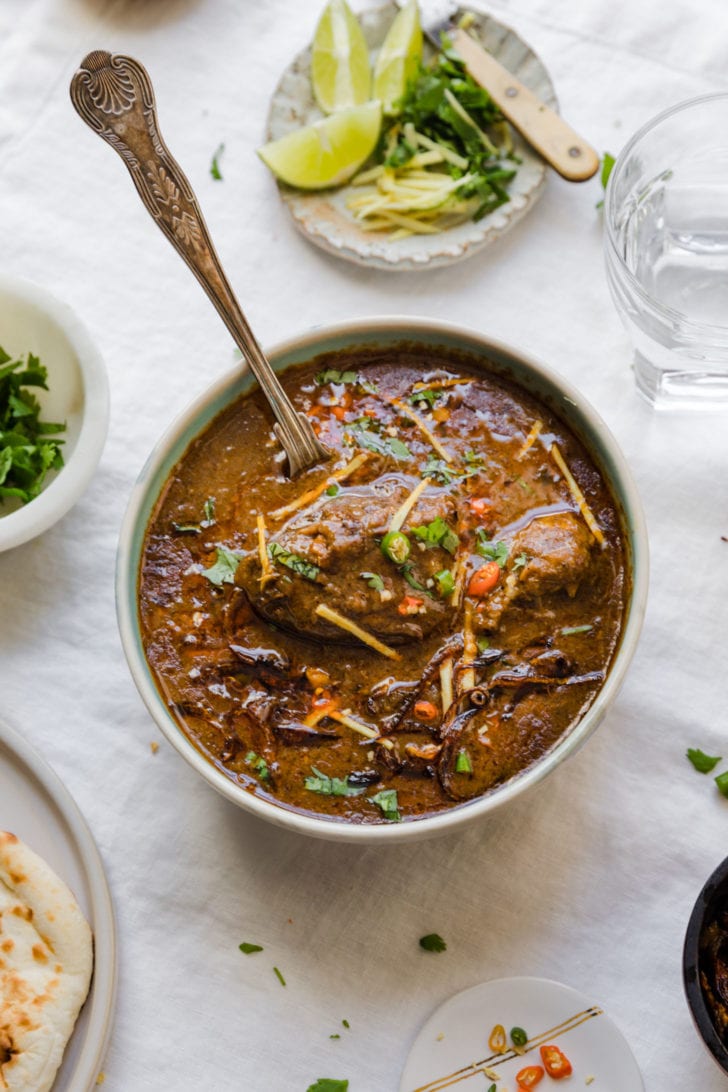
Want to save this post?
Enter your email below and get it sent straight to your inbox. Plus, get recipes & tips every week!
“Loved this recipe so much! I just made it for my boyfriend for his birthday and he said it was a solid 10/10 lol.”
Kimberly
Five years ago almost to this day, I published the slow cooker version of this Nihari recipe. Since then, it’s consistently been one of my most popular recipes. To be honest, I’ve often thought of improving it. (I’m always learning!) But, I dare not touch it since so many people have loved it over the years. I did update a couple things that were long overdue:
- I’ve shared stovetop instructions because are we still using slow cookers in 2021? (Psst…For those who’ve moved on to Instant Pots, here’s my Instant Pot Nihari recipe.)
- I’ve given the option to use homemade Nihari Masala.
Combine both things and I have to say, I like it even better than my original.
What is Nihari?
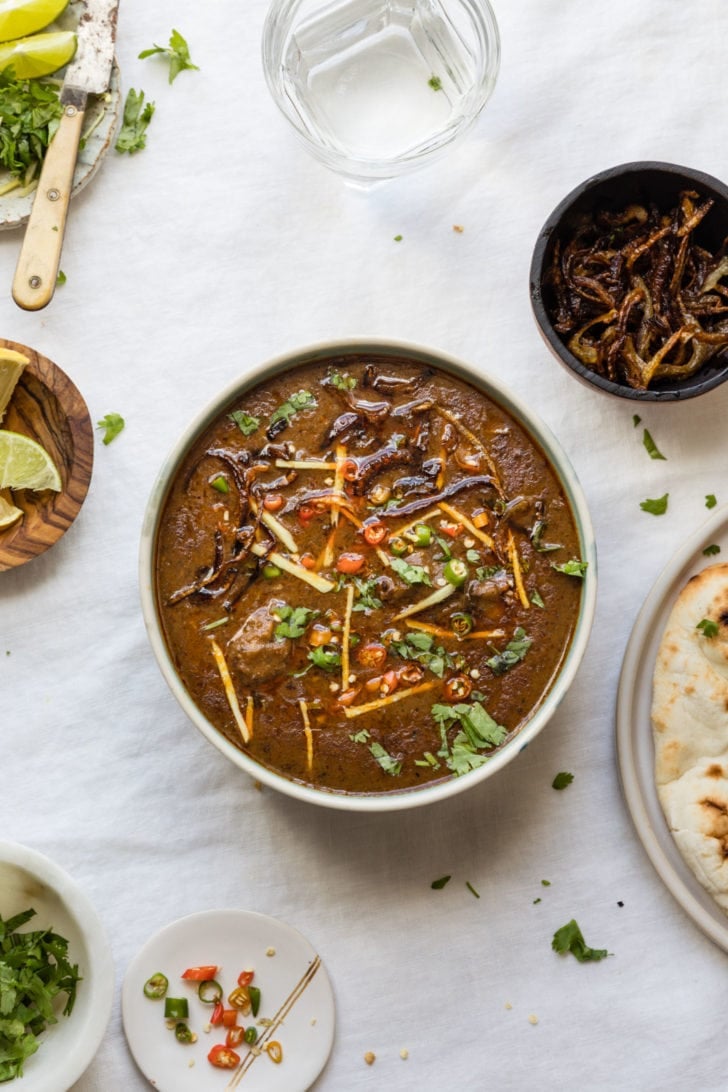
Nihari is a rich, slow-cooked meat stew flavored with spices and thickened with atta, or Pakistani & Indian-style durum whole wheat flour. Pakistani versions of Nihari are typically made with beef, but Nihari can be made with lamb, goat meat, or chicken.
The word “nihari” comes from the root Arabic word “nahar”, meaning “day” or “morning”. This dish is called Nihari because originally, it was eaten in the morning. The history suggests that it started in Old Delhi, where it was eaten by Mughal nawabs and workmen to fuel them throughout the day.
What is Nalli Nihari?
The word nalli means pipe or tube, which conveys the pipe-like bones that are used to make nihari. Nalli Nihari is made with beef bones (typically humerus or femur), which contain yellow bone marrow. This gives Nihari a rich, buttery flavor. Sometimes, the bone marrow is extracted and added to the Nihari.
This recipe doesn’t require bones, but using bone-in meat or bones alongside the meat will enhance the flavor (it’s more essential in the Instant Pot version). If you do use bones, you would need around 1/3 lb extra weight in bones.
Nihari Ingredients
Other than an unapologetically long list of spices, Nihari requires simple ingredients commonly found in Pakistani cuisine:
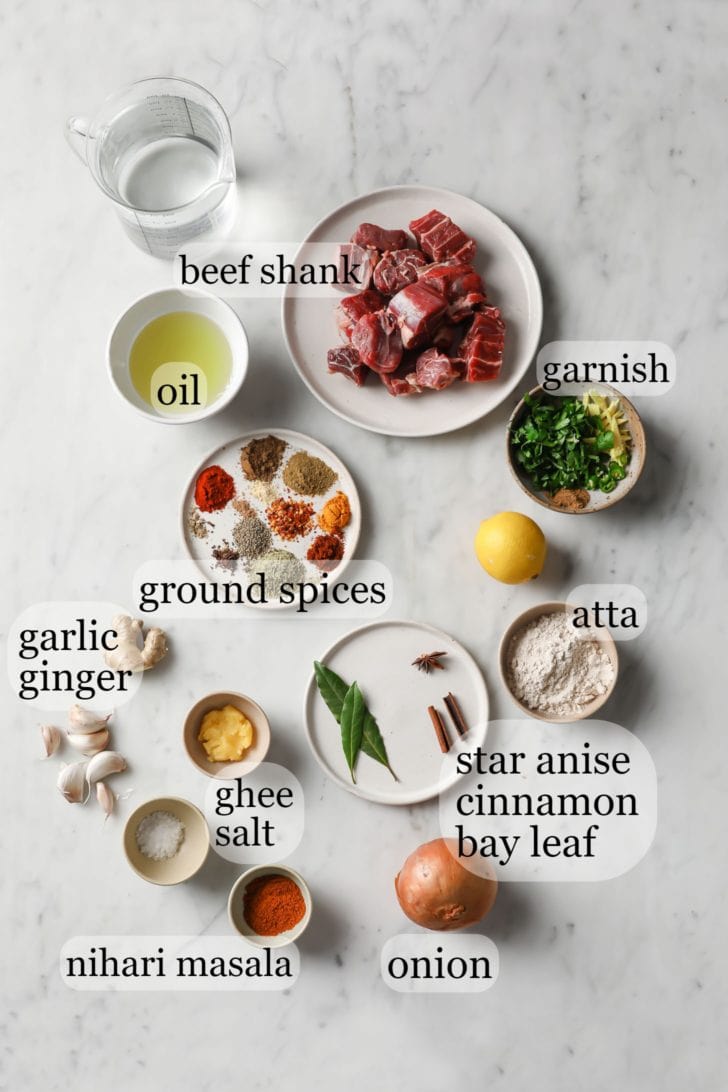
- Atta – Traditionally, atta flour, which is typically used to make rotis, is added to thicken the curry. I highly recommend you use this for an authentic taste.
- Substitute: All-purpose flour. I haven’t tried it myself but have heard from many who have. For added complexity, dry-roast it on a nonstick pan for 6-7 minutes on low-medium heat. It’ll turn a deeper, golden color.
- Spices – This recipe requires either store-bought or homemade Nihari Masala Powder (recipe below!) along with a few other whole & ground spices. As always, if you’re missing a spice (or three!), don’t let that deter you from making it.
What Cut of Meat to Use for Nihari
Nihari is typically made with boneless beef shanks, also called beef shins. Halal grocery stores will often have it labeled Nihari cut. You can also use pre-cut beef stew meat, which is essentially boneless beef that comes from the front shoulder (chuck) or rear muscle (round). If the type of stew meat is specified, I look for shoulder, as I’ve found it to be more tender.
Also, try to find good quality beef. The more marbled-looking it is, the better.
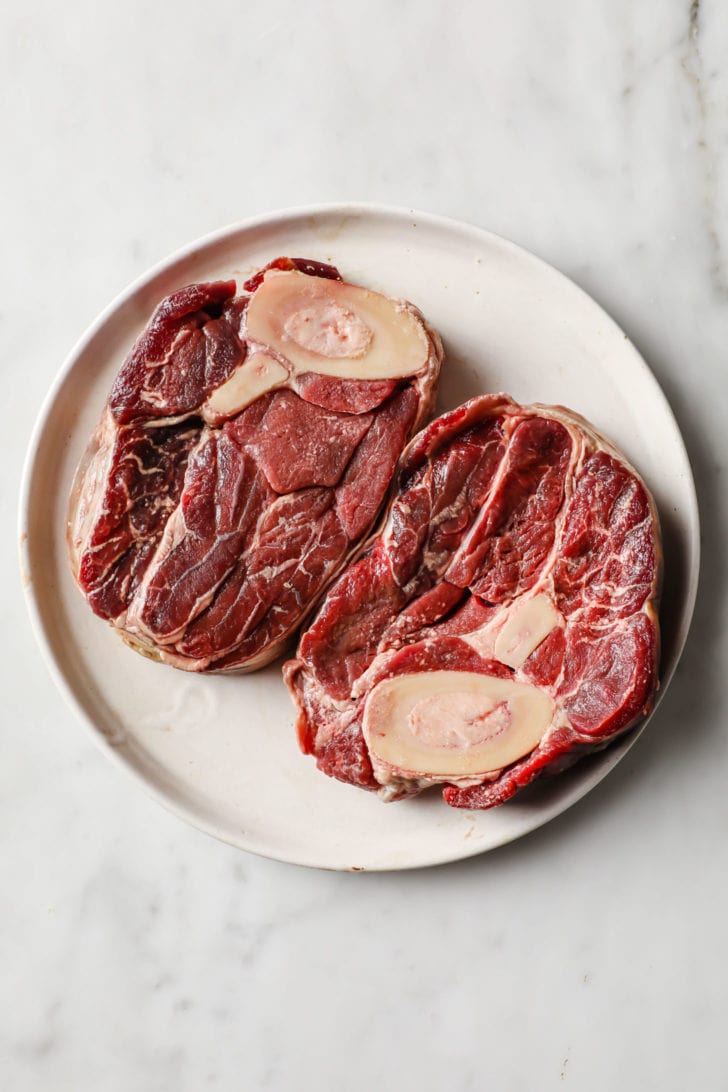
Nihari Masala
Using Pre-made Nihari Masala
Because Nihari demands so many spices, I originally created this recipe using 1/2 a tablespoon of pre-made Nihari masala powder. Use too much of the powder (like the whole packet as the box suggests) and you’ll end up having Nihari that tastes a bit manufactured and a lot like your fellow Pakistani neighbor’s Nihari because they used the same powder. Use just a bit and it’ll give your dish an extra oomph and good color.
Also, I’ve had many questions about using *just* the spice mix. I’m not above using pre-made spice mixes, but I prefer not to use the suggested quantities because it can taste quite harsh. Plus, the flavors are just more pronounced when you use fresh spices. Keep in mind that you’ll need to adjust the salt/spice level depending on which brand and how much masala you use.
Homemade Nihari Masala
As always, I prefer to use fresh, homemade spices when I can. It took me a while, but I finally created a Nihari Masala Powder that works with this recipe.
Nihari Masala – makes ~1 tbsp, all of which you’ll use
- ½-1 tsp Kashmiri red chili powder or paprika, for color
- 1 small black cardamom pod
- 1 small (1- inch) mace blade (or piece of mace)
- 3/4-inch peepli (long pepper)
- 1/4 tsp fennel seeds (saunf)
- 1/4 tsp garam masala powder
- 1/4 tsp ginger powder
- 1/4 tsp onion powder
- 1/8 tsp caraway seeds (shah zeera)
- 1/8 tsp nigella seeds (kalonji)
- pinch cane sugar
To make this Nihari Masala powder, combine all of these ingredients in a spice grinder and process until a powder forms.
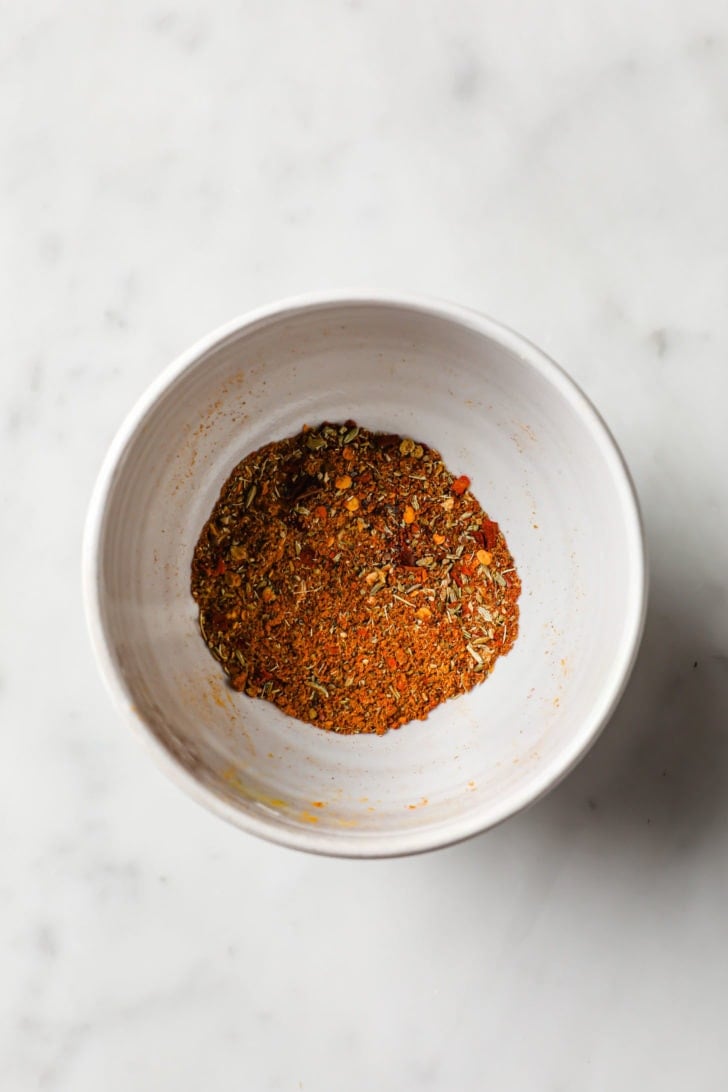
How to make Nihari
The key to a great nihari is intentional depth of flavor. Deeply brown onions, fresh spices infusing the oil, meat that’s properly braised..all this contributes to the revered taste of nihari.
- Brown the onions & meat. Deeply brown onions (refer to the video rather than the pic for reference) give flavor, body, and depth to Nihari. Like with most stews, searing the meat so that it browns is essential, but don’t sear for too long as it can lead to tough meat.
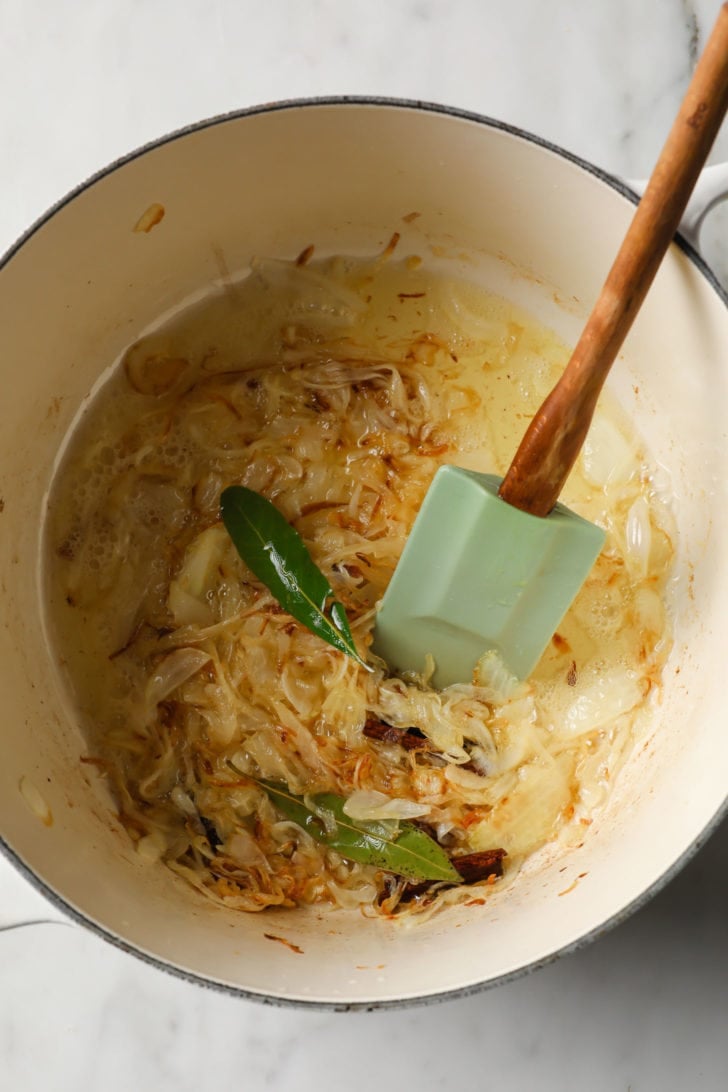
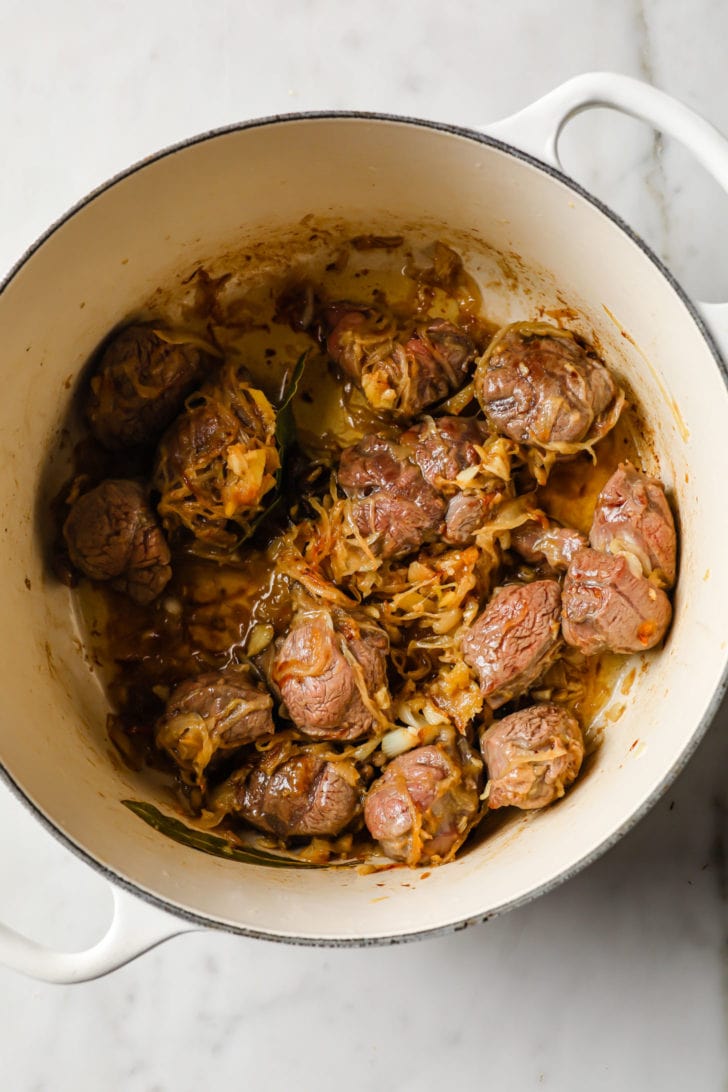
- Bloom Spices. Add spices and allow them to cook in the hot oil. If you’re worried about them burning, you can always add a splash of water.
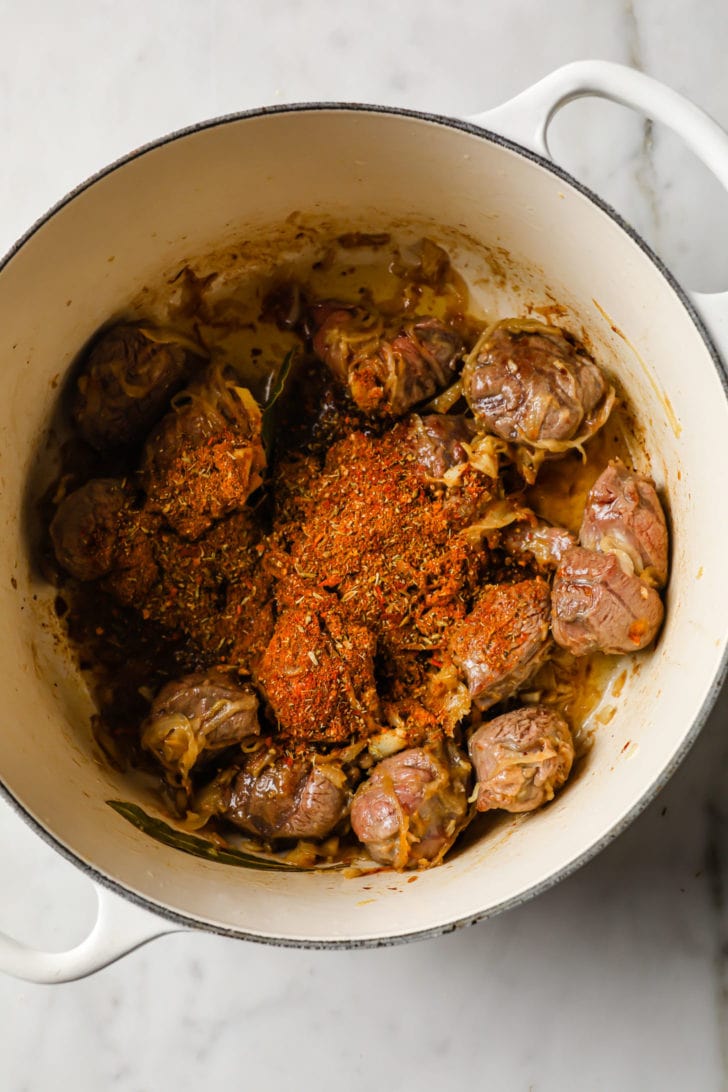
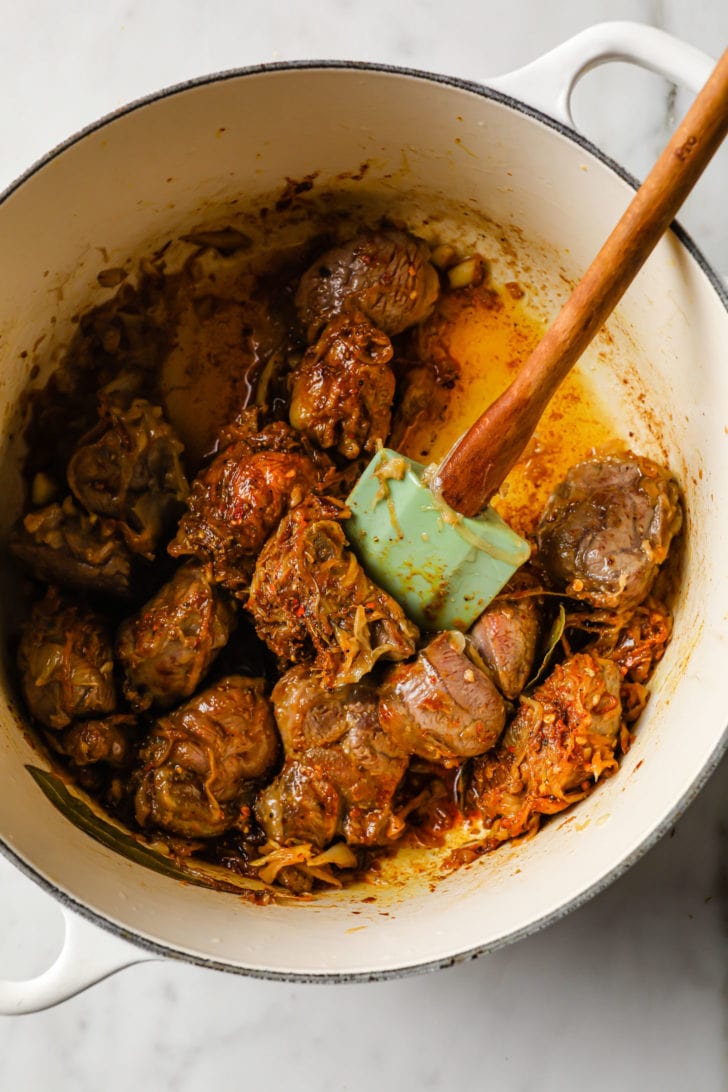
- Cook. For stovetop, allow it to come to a boil before lowering the heat to a simmer. For slow cooker, transfer the mixture to a slow cooker, add water and mix to combine.
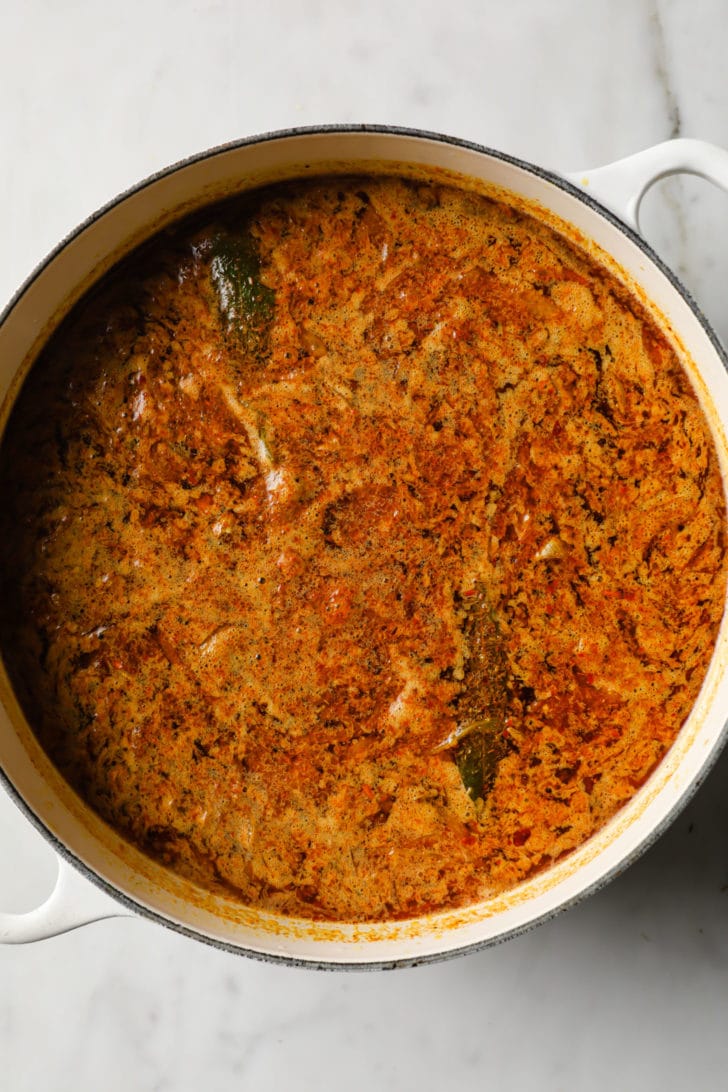
- Thicken. If you try to thicken the gravy by adding in flour, it will result in clumps. To avoid this, remove some of the nihari liquid (I always found using water dilutes the taste) and allow it to cool. Then stir it into the atta flour. Add this slurry to the nihari while stirring to prevent clumps. Allow this to cook and thicken.
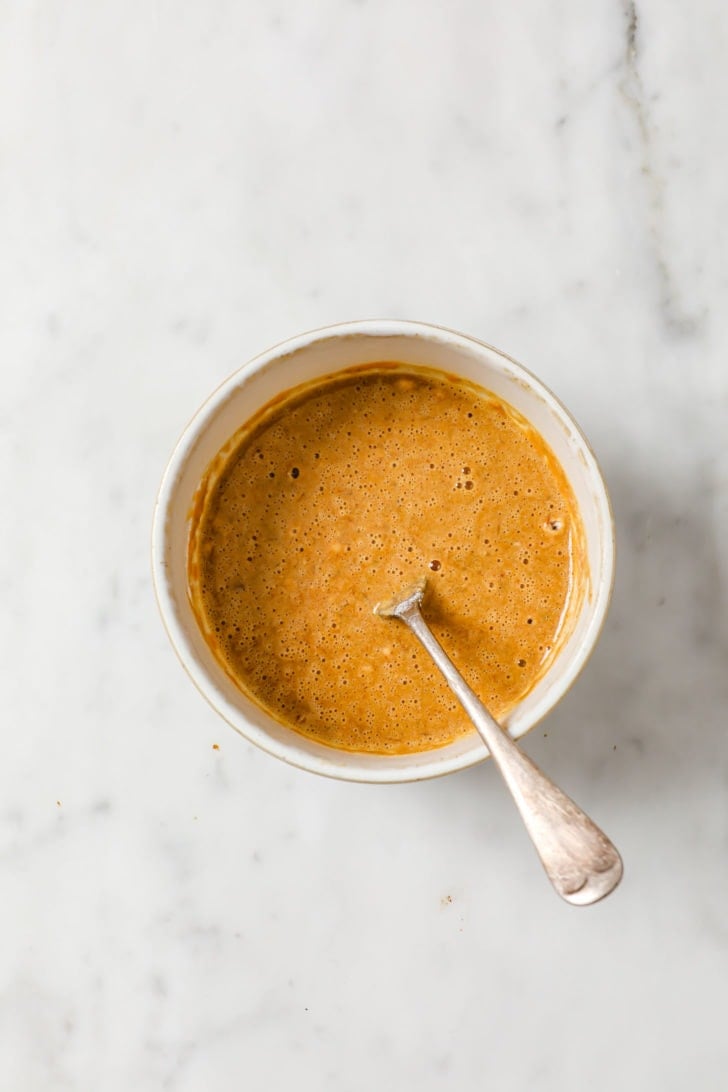
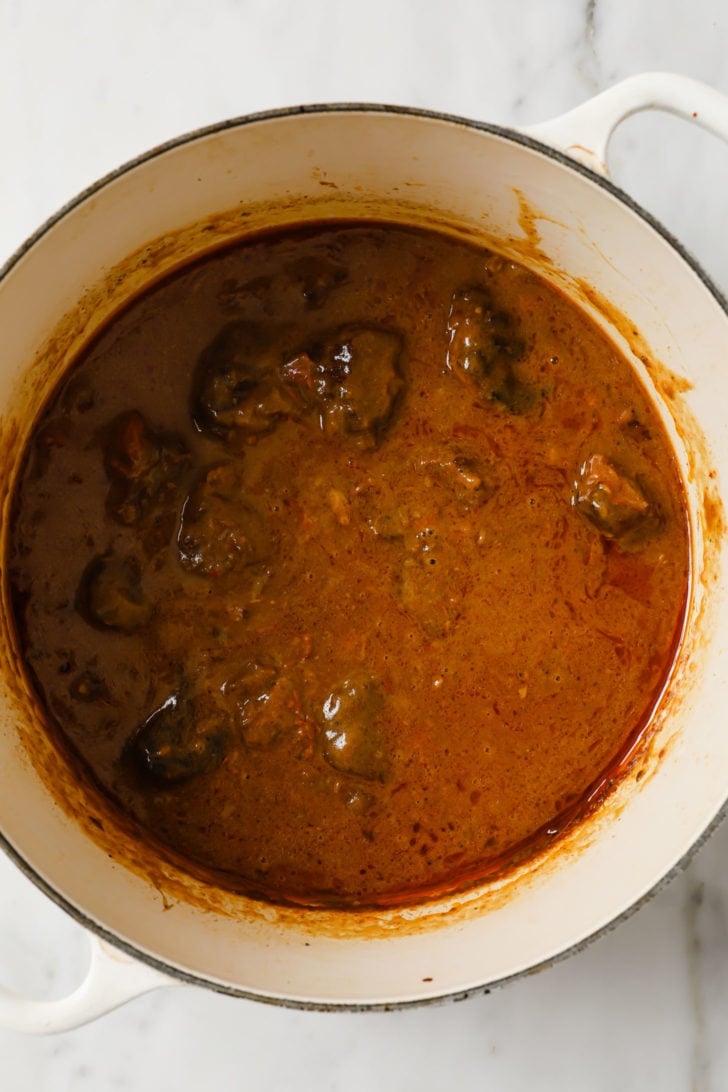
How to get the oil (tari) on top of Nihari
Once a curry is cooked, the fats and oil naturally surface to the top. Typically with Nihari, the oil releases once meat has cooked and also once the atta is cooked. Since I don’t use as much oil as some traditional recipes, it won’t appear as oily as most restaurant Niharis.
To the get oil to rise to top, allow to simmer uncovered on low heat for 5 minutes after you’re done cooking. You can also either reserve oil before adding the atta or add a tarka (tempering of oil) with spices to give Nihari its distinct layer of oil on top.
More Tips for Making Nihari
- Nihari meat should be very tender. It’s not done once cooked, but when it’s practically shredding to the touch.
- The end result should be like a thick soup or gravy. If it gets too thick, simply add (preferably boiling) water to thin it out. Sauté again to desired consistency.
- If using a slow cooker and the end result is too thin, transfer to the stovetop to thicken to your desired consistency.
- Restaurants will often keep the pieces very large (~3-4 inches). Kenji López-Alt points out that large cuts keep the meat more tender. I typically go for smaller sized cubes because it’s easier to eat & serve than a handful of large chunks.
- Variation: For more body and slight tang, whisk in 1-2 tbsp yogurt to the atta slurry before adding it to the Nihari.
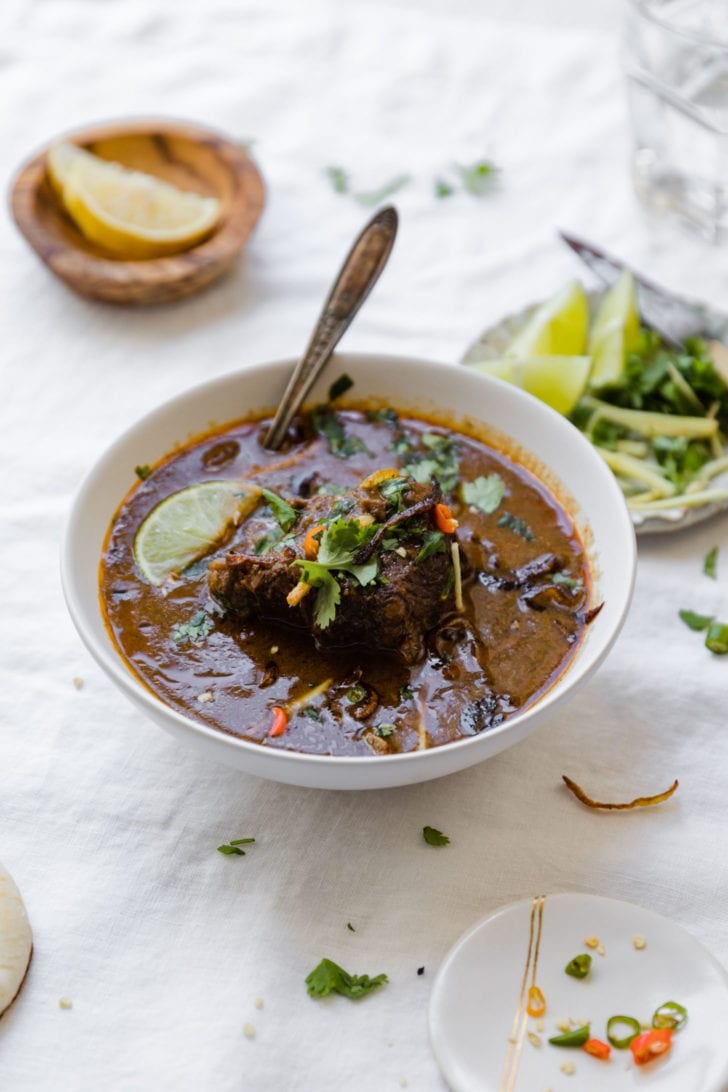
How to make Gluten-Free Nihari
After several experiments, I figured out how to make the best gluten-free version of nihari. You simply dry roast brown rice flour or sorghum flour for 3-4 minutes on low-medium heat and use it as a substitute for atta flour. Dry roasting it enhances the flavor and replicates the earthy taste of atta. Try it with my gluten-free no-yeast naan!
What to serve with Nihari
Similar to Haleem, Nihari is typically served as a main dinner course or brunch dish. It’s generally served with naan or sheermal, a slightly sweet flatbread.
Garnishing is always served alongside nihari. Lemon wedges, julienned ginger, chopped cilantro and (tolerable) chopped green chili peppers are essentials. They bejewel your Nihari while enhancing the spicy, tangy, and crunchy factor.
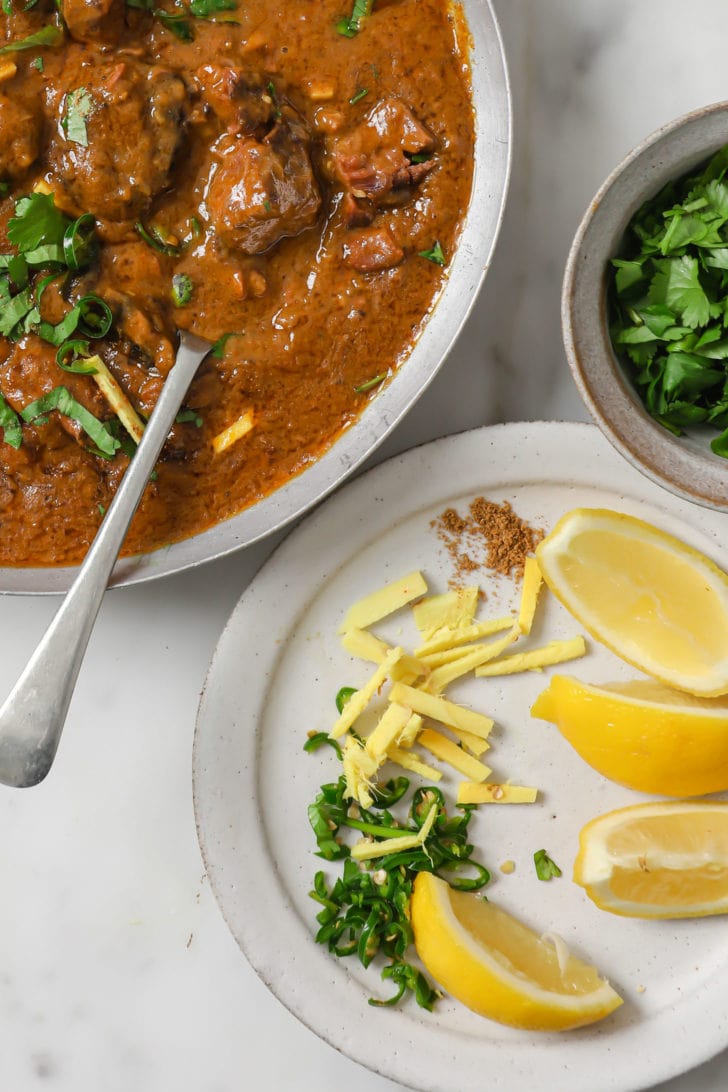
FAQs
To thicken Nihari, allow it to cook uncovered so that it reduces down. You can also add more atta than is called for in the recipe.
Yes! Because it’s a stew with no vegetables or water-based ingredients, Nihari is naturally freezer-friendly. It’s best reheated on the stovetop with some extra water. Be mindful with stirring so the beef doesn’t break.
I haven’t tried making with chicken yet, so I can’t say what changes it’ll need in terms of spices & balance. If you’re wanting to use chicken, you’ll cook for much less time (bone-in chicken pieces have a cook time of around 30 minutes over low heat).
To double the recipe, double everything but the water. A rough estimate: If using a slow cooker, use 2 cups per pound of beef instead of 3 or 3 1/2. If making it over the stovetop, use 6 cups instead of 9 cups per pound.
Tried this recipe? If you have a minute, please leave a comment & star rating below and tell me how it was! If you’re on Instagram, please tag me so I can see your creations. I truly love hearing from you! Thank you!
More Pakistani Beef Recipes You’ll Love
- Pakistani Beef Kofta Curry (Meatball Curry)
- Easy Pakistani Haleem Recipe (Instant Pot)
- Pakistani Seekh Kebabs (Ground Beef Skewers)
- Chapli Kabab
- Easy Instant Pot Pakistani Beef Curry (Stew)
- Aloo Keema (Ground Beef & Potato Curry)
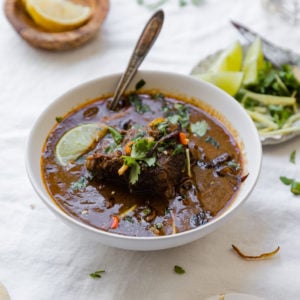
Easy Nihari (Pakistani Beef Stew)
Watch the Video
Ingredients
Whole Spices
- 1/2 piece of a small star anise
- 1-2 small bay leaves
- 1 inch piece cinnamon stick
Ground Spices
- 2-3 whole cloves, ground into a powder using a mortar and pestle
- 2-3 green cardamom pods, seeds ground into a powder using a mortar and pestle
- 1/2 tsp fennel seeds, ground into a powder using a mortar and pestle
- 1/2 tsp paprika powder
- 1/2 tsp coriander powder
- 1/2 tsp cumin powder
- 1/4 tsp turmeric
- 1/4-1/2 tsp red chilli powder or cayenne
- 1/4 tsp crushed red chilli flakes
- 1/4 tsp black pepper powder
- 1/8 tsp garlic powder (optional)
- pinch nutmeg
- 1 tbsp Homemade Nihari Masala (recipe in post), or sub 1/2 tbsp store-bought
Nihari
- 1/3 cup canola or other neutral oil
- 1 tbsp ghee, or butter
- 1 large (250-270 g) onion, thinly sliced
- 5-6 garlic cloves, crushed
- 3/4 inch piece ginger, crushed
- 1 1/4 tsp salt (sea salt or table salt), start with 1 1/2 tsp if using homemade masala
- 1/4 cup (35 g) durum atta flour, (Or sub dry roasted brown rice flour or sorghum flour for GF)
- 9 cups water for stovetop, 3 1/2 cups for slow cooker
- 1 lb (454 g) boneless beef shank meat, 2-inch cubed, or sub beef stew meat, 1 1/2 inch cubed
Garnishings
- 1 tsp garam masala
- crispy fried onions
- 1 inch piece ginger, julienned
- 1 lemon, cut into wedges
- 1/4 bunch fresh cilantro, chopped
- 1-2 green chili peppers, chopped
Equipment
- Dutch oven OR Slow Cooker
Instructions
Stovetop
- Heat oil and ghee in a heavy-bottomed Dutch oven or pot over medium-high heat. Add the whole spices and onion, and sauté until the onion turns golden, about 10 minutes.
- If needed, deglaze with 2 tbsp of water. Once the water dries up, add the garlic and ginger and continue to sauté for 30 seconds. Add beef and sauté for about 5 minutes, or until it changes color.
- Lower the heat and add the powdered spices and salt and sauté for about 20 seconds. Immediately pour in the water and stir to mix.
- Raise the heat to high and bring to a boil (cover with lid to make it boil quicker). Then lower the heat to low/low-medium so that the nihari is gently simmering. Cover and allow to cook for 6 hours for beef shank meat (or ~4 hours for stew meat). Turn off the heat. The meat should be tender enough that it breaks easily when pressed with a wooden spoon. Remove the whole spices, if desired.
- Take out a cup of the liquid of the Nihari onto a bowl or measuring cup. Let it cool a little by adding an ice cube to it. Place the atta in another small bowl. Bit by bit, whisk the Nihari liquid into the atta to form a smooth slurry (small clumps are okay). Slowly stir this slurry back in to the Nihari pot to prevent clumps. If the mixture is too thick, add (preferably boiling) water to reach desired consistency.
- Raise the heat to high to bring to a simmer. Then lower the heat to low/low medium. Cover and allow the nihari to simmer for another 30-45 minutes. The consistency should be like a thick soup. Serve hot with the garnishing and naan or sheermal.
Slow Cooker
- Heat a medium pot over medium-high heat. Heat oil and ghee and add the whole spices. Add onion and sauté until golden, about 10 minutes.
- If needed, deglaze with 2 tbsp of water. Once the water dries up, add the garlic and ginger and continue to sauté for 30 seconds. Add beef and sauté for about 5 minutes, or until it changes color.
- Lower the heat and add the powdered spices and salt and sauté for about 20 seconds.
- Carefully pour this beef mixture into your Crockpot or slow cooker.
- Add the water and stir to mix. Cook on low for 8 (for stew) to 10 hours (for shanks) or high for 6-7 hours, or until the beef is fall-apart tender. Cooking times will vary depending on your meat and slow cooker.
- Toward the end of your cooking time, remove your whole spices and take out a cup of the liquid of the Nihari into a bowl. Let it cool a little by adding an ice cube to it. Place the atta attain another bowl. Bit by bit, add the Nihari liquid to the atta to form a smooth slurry. Slowly add this slurry back into the crockpot while stirring to prevent clumps. Let it cook for another 30-45 minutes. Serve hot with the garnishing and naan or sheermal.


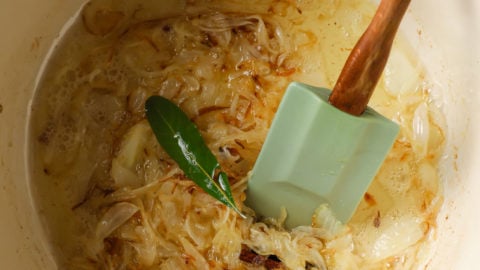
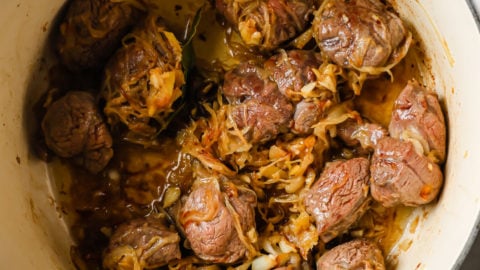
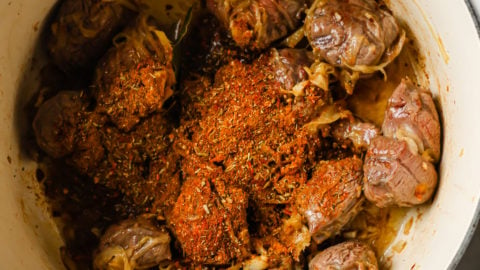
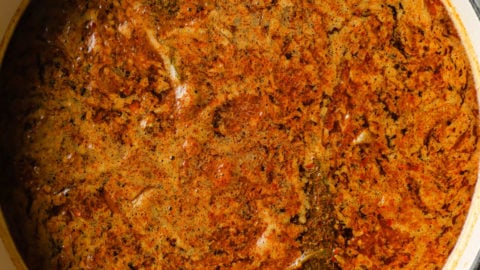
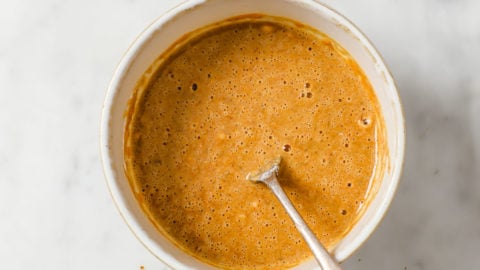
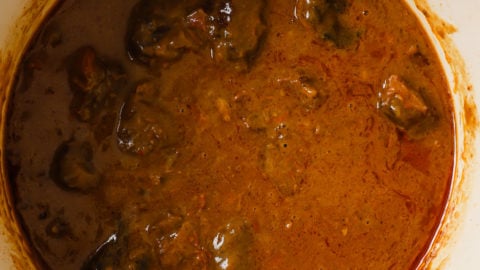
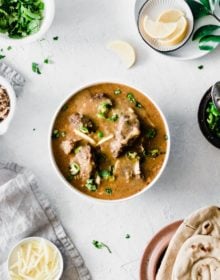
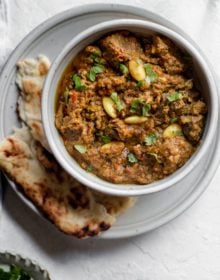
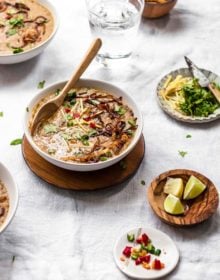

152 Comments on “Easy Nihari (Pakistani Beef Stew) – Stovetop + Slow Cooker”
I dont have a slow cooker (yet) , curious if I can still follow the recipe and continue to cook it on low heat for the recommended 6-7 hours? Would that work?
Hi Hiba,
Yes, you can most certainly cook it without a slow cooker. That said, the liquid doesn’t evaporate in a closed slow cooker. So you will need to use more water if you cook it on the stovetop. I would say start with the ratios of water in the recipe, let the water cover the nihari meat and then add more as needed. Hope this helps!
If I double the recipe should I double the spices also??
Fiza, you will double the powdered spices but not the whole spices. (i.e. don’t double the cinnamon, star anise, and bay leaves). Also, don’t double the quantity of water as it will become too diluted. I’d say 6 1/2 cups at most or just enough to cover the meat so it gets submersed in water. Hope that helps!
Hi,
How much meat did you use for this recipe?
1 lb 🙂
I made Nihari using this recipe and it was very good! I have saved it and I will be using this recipe many more times in the future. The only thing i changed is that I added a few beef bones just to have more of the beef flavor.
Owais, I’m very happy you enjoyed it so much! I’m hoping to try it with bone sometime too! Thanks so much for your review.
Thank you so much for the amazing recipe! Just made it over the weekend and was given 2 thumbs up from my husband and children!
I’m so glad to hear that, Huma! Thank you for letting me know!
The recipe looks amazing. I would love to try this with lamb instead of beef. Will I need to adjust cooking times and water content? Also what part of the meat do you use? I usually use lamb shoulder or lamb leg. Which would you recommend? Thank you.
Thank you, Sajeda! I haven’t tried it but lamb should work fine. Yes, you’ll probably decrease the cooking time by a couple of hours and use 1/2-1 cup less water. (I’m guesstimating over here 🙂 ) Also, I think lamb shoulder should work better, but, again not completely sure since I haven’t tried it. Hope this helps. Let me know how it turns out for you!
Thank you so much for the recipe. I did end up making it and it was a big hit with the family! Unfortunately, I didn’t take any pictures but will be making it again soon and will tag you on Instagram!
I made some slight adjustments as I was using lamb. I just asked the butchers for meat for nihari and they gave me meat that was on the bone and them some extra bones with marrow which really added some authenticity to the food. Spices and water content I kept the same. The only thing I changed really was that I transferred the mixture over to a traditional pan on the cooker when I added the atta to it as my slow cooker was a tad just too small.
Thank you again for the recipe! (Also, will just add as a final note that it really does make all the difference using the traditional spices as opposed to the boxed spices!) The flavour and fragrance is just amazing.
Sorry, I should add, the meat specifically was lamb shanks! X
Aww, thank you Sajeda! A review is even better haha. I really appreciate that you took the time to review it and I’m so glad you all enjoyed it! You’re right, nothing matches using good old spices! 🙂
Thank you v much for the recipe. I’m using a pressure cooker on low heat and have set everything in it as described. Can you tell me how to adjust the time and water content with a pressure cooker??
Mujtaba,
You’re welcome! I have not tried it in the pressure cooker but I believe on low it will still have to cook for at least 3 hours and you’ll have to add 7-8 cups of water. You might want to check on it after a couple of hours. Hope that helps. Let me know if you have any more questions.
Thank you for the prompt reply. I checked it at 3 hours and added atta which improved the consistency a lot. My family is loving it. A big thank you from all of us in Columbus, Ohio.
Also found a wealth of info on your website. Have a blessed life.
Yes, the atta is a must. 🙂 You’re welcome. I’m very glad you all enjoyed it! Thank you for your compliments and well wishes.
Can you cook on high instead of low and for how long if you can. I’m cooking at working (husband and I work together all day) with a one year old.
Annie, I have tried cooking it on high and found that it took about the same time to get the meat as tender as Nihari meat should be, about 6 hours. I think you will be fine leaving it to cook on low for more than 8 hours. 🙂
This sounds really good!
Thank you, Anne! Do let me know if you try it! 🙂
Hey- thanks for the recipe! Do you think I can use them Shan masala instead of the whole and ground spices?
You’re welcome Sumera!
Yes, you can but try not to use too much as the box suggests. I would suggest 2 tablespoons at most. Try to add at least some of your own spices for a fresh, homemade taste. Hope that helps and let me know if you have any other questions!
Hi,
I wanted to try the slow cooker nihari recipe but wasnt sure what ratio to use bones and meat. And how will the cooking time differ if it does change? My husband loves nihari but without the bones etc its not really for us
Hi Kiran, you would need at least 1/3 (a third of a pound) of bones, but feel free to use more if desired! The cooking times will be the same!
Salaam,
Yesterday I bought myself a slow cooker and thought I’d try your nihari recipe. I was a little sceptical about how the dishes in the slow cooker will come out but I have to say your nihari recipe came out amazing!!!! My husband and I absolutely loved it. It took about 15 mins total prep and browning and then that’s it. My kitchen smelt lovely but was nice and clean and the dish was perfect. Jazakhallah khair. Please post more slow cooker recipes, other family .members are now thinking of buying a slow cooker thanks to the success of your recipe.
How Amazing! I’m honored and very happy to hear this. Thank you very much, Sabrina.